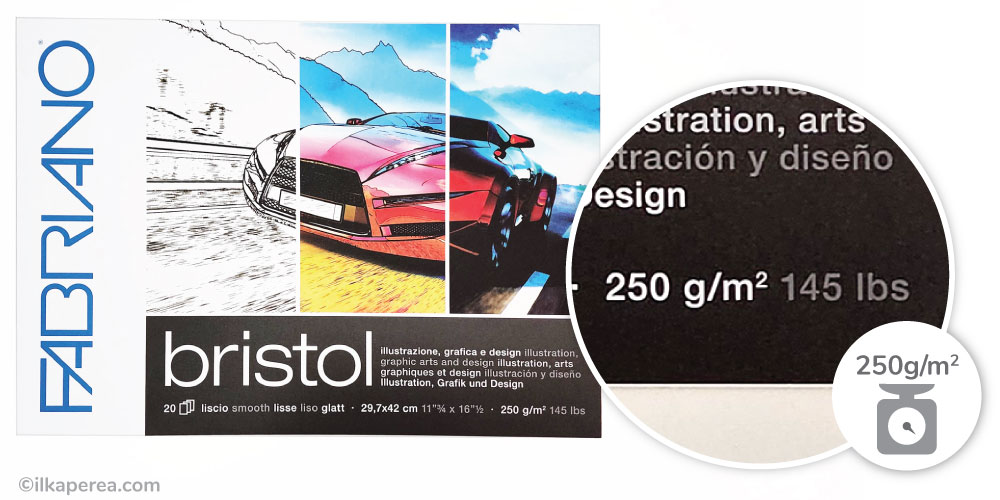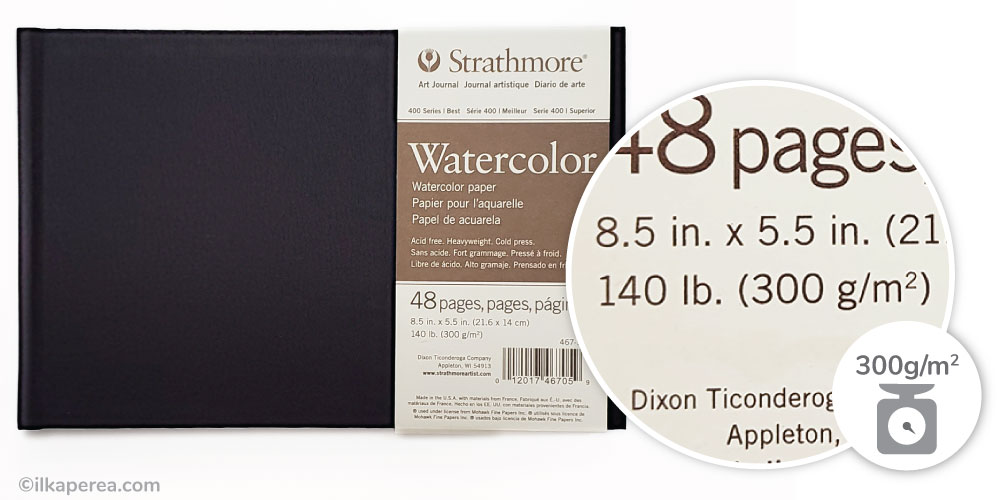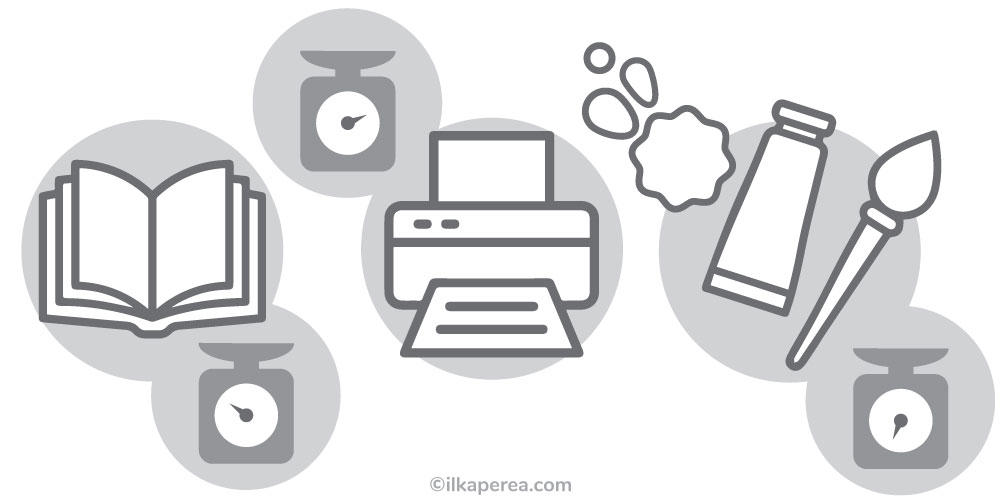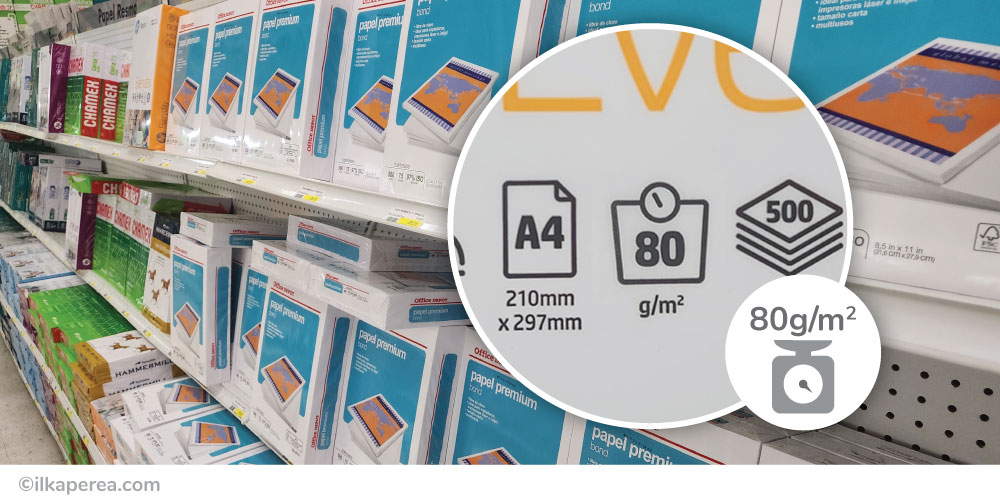Paper Grammage for Graphic Design
Last Updated on: 21st March 2024, 01:31 am
Choosing between diverse types of paper is not always easy, given the great variety offered by the market. One of the variables to take into account is its grammage. Discover in this post, the most suitable paper grammage for graphic design, according to the project to be worked on.
The term “grammage” refers to the weight, also to density of the paper. Paper grammage is important for the quality of print work and illustration or technical drawing projects, so choosing the right paper grammage always leads to the best results.
This post I will explain to you some relevant details about paper grammage, the difference between grammage and thickness, other features of paper properties available on the market, and some recommendations for its application as a graphic design medium.
Table of Contents
- Grammage
- What means Paper Grammage?
- How is the Grammage calculated?
- Matching Paper Grammage to Purpose
- Grammage vs Thickness: what is the difference?
- Method of Paper Processing
- Amount of Wood Fibers
- Other kinds of Fibers
- Paper Grammage Usage
- Paper Grammage and Their Usage in Graphic Design
- Summary
- Some Insights
- Any Thoughts?
What means Paper Grammage?
Grammage can be technically defined as “the weight of a sheet of paper with the area of one square meter”, or the ratio between the weight of the paper and its area. It is measured in grams per square meter (g/m²) or simply in grams (g). It is also possible to get drawing paper weighed in two ways: in pounds and in g/m².
In most offices, one can find bond paper for printers with a grammage between 70 g/m² and 80 g/m². But a paper grammage of 100 g/m² is also popular in offices today. In addition, paper grammages ranging from 60 g/m² to 300 g/m² (depending on the type of project) are generally used in graphic design.

How is the Grammage calculated?
To calculate the paper grammage, use the following formula:
Sheet format in cm x paper weight (g / m²)
_____________________________________________
10,000 x number of sheets
Some kinds of paper, mostly drawing and painting paper, are weighed in two ways: in pounds and in g/m². To determine the weight in g/m², the manufacturer weighs a sheet of paper measuring 1m x 1m. In the same way, the manufacturer weighs five hundred (500) sheets of the same size paper to determine the weight of the paper in pounds. The resulting total is the weight you see written on your watercolor pad, for example, 246 lbs.

Thus, depending on the paper grammage, the paper types should be understood in such a way that a higher paper grammage reflects, at the same time, a higher strength or tear resistance.
However, there is a common perception that the heavier the paper, the better the quality. This is not entirely accurate. The grammage of the paper depends on its purpose, so each kind of paper has a typical weight.
Matching Paper Grammage to Purpose
Paper grammage is not necessarily an indicator of quality. Instead, paper weight should be used to help determine whether the paper and the intended substrate are a good match.
Let’s look at these cases:
Sketch paper is thin and light. It can weigh between 30 and 60 pounds. As its name suggests, it is for sketches, not for finished drawings. Its weight and cost make it the ideal choice for drawing thumbnails, composition sketches, or lining up ideas.
Watercolor paper is thicker and heavier because it must resist the humidity of the wet medium applied to it. This usually weighs between 90 and 200 pounds.

Graphite drawing paper does not need the durability of watercolor paper but is heavier than sketch paper. It usually weighs between 70 and 100 pounds.
The grammage you choose will depend on how you work with your medium.
Grammage vs Thickness: what is the difference?
In many cases, a higher grammage also means a higher thickness, but the thickness can also depend on other factors:
Method of Paper Processing
The processing method used in the paper mill may give the paper a higher density, which means that the paper has a lower strength. I mean, if a single gram of paper occupies a volume of 1 cm3, it possesses a bulk value of 1.0. Consequently, a lower bulk value indicates a dense composition, with minimal air interspersed between the fibers. Conversely, a paper boasting a higher bulk value signifies a considerable amount of airspace amidst the fibers, resulting in a thicker texture without a proportional increase in weight.
Amount of Wood Fibers
It could be shredded wood pulp, which is obtained by mechanical processes; or cellulose, which is obtained by chemical means. The more wood fibers it contains, the stronger the paper will be. Paper made from cotton fibers is generally heavier and thicker than paper made from cellulose.
Other kinds of Fibers
Certain substances that influence strength can also be used in papermaking. Paper manufacturers use plant-derived substances to reduce the number of wood fibers required or to achieve a special haptic or visual effect (algae, coffee, olives, oranges, or corn).
Consequently, two sheets with the same grammage may have different thicknesses due to the manufacturing process or the composition of the paper.
Paper Grammage Usage

Paper Grammage and Their Usage in Graphic Design
Depending on the grammage of the paper, it can have different uses and can be used for several kinds of graphic design projects or artwork.
- Paper grammage 40 g/m²: tracing paper to transfer a drawing onto a surface for painting.
- Paper grammage 50 g/m²: is often used in newspaper printing.
- Paper grammage 70-90 g/m²: standard office paper, sufficient for simple printing, photocopying, faxing, etc. Designers use it for sketching or practice paper because it is thick enough to work on with pencils, charcoal, or pastels.
- Paper grammage 100-120 g/m²: higher quality paper, suitable for commercial documents such as information and brochures or classic stationery. As drawing paper, it is suitable for finished artwork in most media.
- Paper grammage 130-170 g/m²: resistant paper, suitable for advertisements, brochures, posters, and inside pages of brochures.
- Paper grammage 170-200 g/m²: fine cardstock paper, suitable as outside pages of brochures and magazines, for flyers printed on both sides as well as high-quality posters.
- Paper grammage 200-250 g/m²: stronger cardstock paper, suitable for sturdy outer pages of brochures and magazines as well as postcards.
- Paper grammage 180-260 g/m²: heavy weight drawing paper, bristol, multi-media papers. Grammage in this range is like card stock or light poster board.
- Paper grammage 300-400 g/m²: thicker card stock, ideal for business cards.
- Paper grammage over 400 g/m²: thick poster board, suitable for particularly high-quality business cards. Graphic Artists use it for painting (in watercolor journals) rather than drawing.
Summary
- Grammage can be technically defined as “the weight of a sheet of paper with the area of one square meter”, or the ratio between the weight of the paper and its area.
- Paper grammage is not necessarily an indicator of quality.
- The grammage you choose will depend on how you work with your medium.
- Two sheets with the same grammage may have different thicknesses due to the manufacturing process or the composition of the paper.
Some Insights
The thickness of the paper also determines its grammage and can therefore influence the cost of shipping. To save shipping costs, designers should choose exactly the paper whose grammage is required and demanded by the project they are working on.
Paper size and its whiteness are other aspects to consider when choosing paper, as well as its impact on the environment. Since paper with a low whiteness usually has a high recycled content, it is perfect for all purposes where what matters is purely the content and less the “appearance”.
Any Thoughts?
In the comments section, tell me if you already knew about paper grammage. As a designer, what paper grammage do you use most often?

Share
Spread the love… and this post!
If you liked it, share this post on your social networks. Smart designers share good things with others.

Bibliography
- Asuncion, J., Vidal, A. (2003). The Complete Book of Papermaking. Lark Books.
- Dabner, D., Stewart, S., Vickress, A. (2020). Graphic Design School: The Principles and Practice of Graphic Design (7th ed.). Wiley.
- Hunter, D. (2011). Papermaking: The History and Technique of an Ancient Craft. Dover Publications.
- Kurlansky, M. (2017). Paper: Paging Through History. W. W. Norton & Company.
- Meggs, P. B.; Purvis, A. W. (2016). Meggs’ History of Graphic Design (6th ed.). Wiley.




